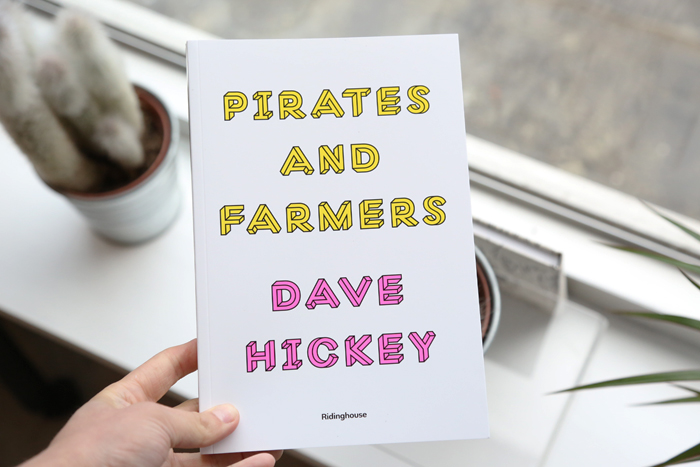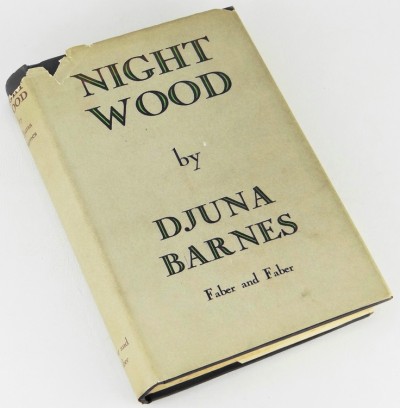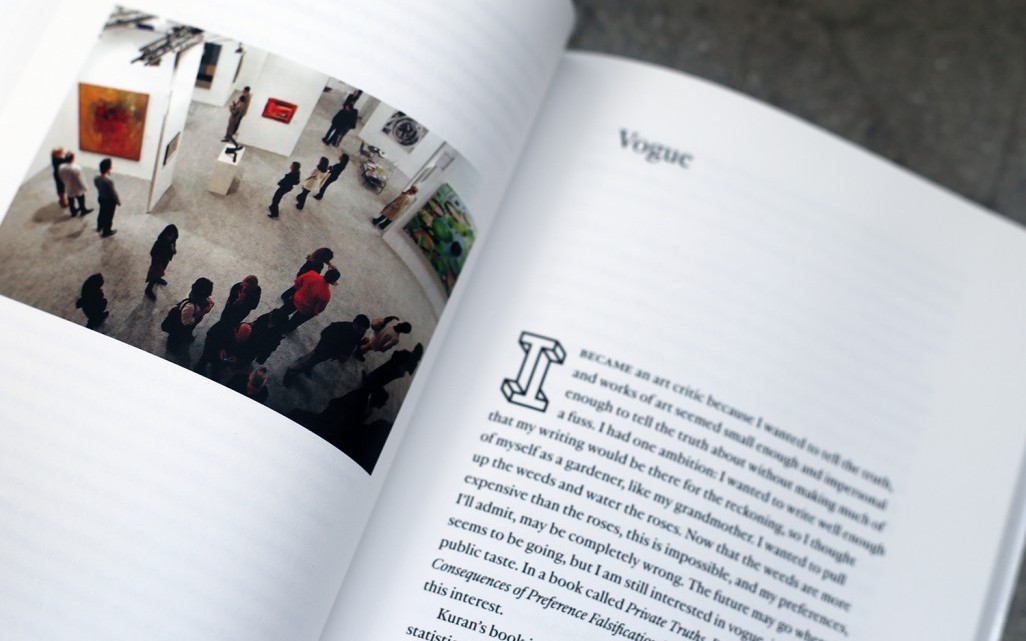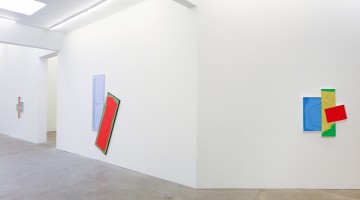One of the things that surprises me to no end, and this is an operation of power, is that people feel unable to just go do something else. My ever-ready “plan B” is to move to the beach with some hot guy—it’s always on the table so I never feel trapped into playing this game I don’t want to play. We’ll see how long that lasts.
That is what I did when I left New York the first time: I went to Nashville. I wrote songs, played in bands, and it wasn’t bad. People today are defining the role of the artist as anyone who wants to be an artist—and that won’t cut it. The idea that even a thousandth of MFAs are artists is laughable, and that makes it impossible for the people who are regular artists. If you’re just a regular artist, whose work don’t come with a social excuse, or a letter from a doctor, you’re kinda fucked.
I thought the essay you wrote on art schools and MFAs was completely correct.
And what happens when you write something like that? Nothing!
Do you normally hear back from people when you publish stuff?
No, I’ve never had a major review and I’ve never had a good review. I met someone at a party in Dublin who claimed to have read my Gober essay. In short, I just sail texts down into the shredder.
Instead, you get profiles and interviews because “you” are the story?
I get profiles and interviews of my boring life. I sell books to kids, although the kids who bought Invisible Dragon are now tenured professors and they’re not my friends anymore. That’s perfectly natural, I guess.
There is a huge distance between the popular perception of what you are about and actually reading your writing. That is why I was interested in the music celebrity thing, where you are thinking about people who have consciously separated things. Your little essay on Flaubert’s A Simple Heart (1877) is so beautiful . . .
Thank you, and no I’m not consciously strategizing. For me, being banished to Nashville was kind of special because Waylon Jennings, Billy Joe Shaver, Roger Miller, and Kinky Friedman were my contemporaries. I felt perfectly at home with them. It wasn’t like “oh you can’t sit here?” Or “did I knock the Wedgwood dish off the table?” Or “did I puke in your hat?” I was comfortable there and I had a wonderful woman named Marshall Chapman who would get me in fights but then she’d fight too. So we cut a swath. Marshall and I were the only two people of our kind in Nashville, except for Waylon and he was much sweeter than we were.
There is an off-hand comment in one of the early sections of Pirates and Farmers that being perceived as high on drugs let other people feel you had an excuse so you could get away with the outrageous things you did.
This sounds terribly condescending but it’s true. Now I miss genteel. I miss Leo Steinberg. I never had much style, but I miss it in the world. For a while we had a good group: Jeremy Gilbert-Rolfe and me and Chris Knight and Peter Schjeldahl and David Pagel and Elaine Scarry—we would be on panels and argue until our faces turned blue but then go out to dinner. People don’t do that anymore.

It is a curious thing, in your writing, that you are very self destructive but not angry.
Right. What could change? I don’t have an IQ syringe. I hate universities because they are pissing on what I love and that is good a reason to hate something. Mostly, I just point out the blemishes on the dying patient.
You don’t often write negatively about art.
I wrote a snarky piece on Clemente but I did say the watercolors are lovely. I wrote a negative piece on Christopher Wool that was not nearly as negative as it should have been. He’s a fucking poser.
For someone who laments the loss of a certain kind of edge why do you not write negative reviews?
What am I going to do, take on Eric Fischl? Why would I take on Marina Abramovic—she’s a first rate idiot. I would have taken on Susan Sontag but she died so I took her on in Harper’s. Oscar said we’re judged by the quality of our enemies.
It seems like your anger toward Sontag is due to the fact that she was really important to you intellectually.
Correct, and that was before she repudiated everything good she had ever written! Against Interpretation (1966) was an important book for me when I was young, but she’s become a role-model goody two-shoes princess.
Auden said something about negative criticism, which is that it mainly serves as an exhibition of the intelligence of the critic and doesn’t tell you much about the art.
Right. I do think its possible to write neutrally about the art and negatively about its mise-en-scène. To be honest when I started writing criticism it was all about the market, and still is to a certain extent — this stuff costs too much, so I’m going to knock the price down. This stuff doesn’t cost enough, I’m going to bring the price up. I came out of the dealer world and that is still how I think.
It seems like part of your persona that annoys people is that you are popular and write accessibly. The way you talk about beauty and vernacular is about being in the world, where no one has a more powerful claim on their perception of beauty than anyone else.
I like Christopher Knight’s statement: the best thing about democracy is that anyone can be an elitist. I am an elitist. I don’t let no shit float by. I had a meeting with the people at the NYT when Michael Kimmelman was going to quit, which he did and continues to do. We just sat down to talk about me taking on a job and it was clear, this is not going to happen.
Why, I don’t understand?
Because they said they couldn’t trust me with NYT liturgy.
There is a problem right now with a lack of any major critical voice that anyone respects. I guess the closest thing is Jerry Saltz and Roberta Smith—
Jerry is a good-hearted village explainer. Roberta has no meta. She writes very well, but you never feel the shape of a metacritical stance from her. She is observant. Michael Fried is an observant man, with whom I disagree 180 degrees, but Absorption and Theatricality is brilliantly observed—he saw that!—he’s wrong, but he saw it. The critics that are out there now? I probably like Richard Schiff the best for being steady and clear. Christopher Knight is good because he is not afraid—he nearly took the Getty down with facts and figures and e-mails. Peter Schjeldahl is a good critic as a poet but when he took The New Yorker job I told him, “The New Yorker is a narrative magazine. Your first line should be something like: ‘The woman standing next to me looking at the Anselm Kiefer blew her nose.’” Peter has never gotten a hook like that past his better self. I do think there are generations that come up feeling entitled. I certainly did— Plagens did and Schjeldahl did, so there are people who never think about compromising. I used to work on the newspaper. They would tell me, “You don’t have to work this hard. We can do second best in a daily newspaper.” I’d say I couldn’t do second best until I figured out first best.
What’s your writing process like?
Fast and then slow. I try to write as fast as I can to let the gremlins in. Then I go back and work on it. I write as fast as I can until I finally get to the beginning.
I really liked what you wrote about On the Road.
Well, as I said, it confirmed that people were living the kind of life I was living at that time. It was a fairly special book. Also Kerouac could write soppy but he didn’t write badly. He just had so much kindness. I think On the Road it is the first great American gay love story.
Are there works of art that you felt that way about? Like that it wasn’t showing you something new but it was confirming your way of being?
Ad Reinhardt’s black show. I like rhetorical art, but a few years of abstract expressionists shouting at you is really too much. When I saw Ad Reinhardt’s black show, I exhaled. It was exactly where I wanted to go, into the darkness of exotic rigor. I saw a show that Henry Geldzahler did of plus-size Ellsworth Kellys at the Met. I was stunned. It the first art that didn’t look like art that I knew was art.
One of the people I’ve heard you talk about with respect is Marcia Tucker. How did you meet her?
Marcia could look at your art and tell how big your dick was but not always if it was good art—she had great instincts about people and no eye. Marcia was just who you wanted to know: she was funny, she was a trollop, she was fearless, she was great. When I had my gallery in Texas I just called her up and made an appointment with her. We had lunch. I liked her a whole lot. She was a whole person. She did everything wrong: she did not have taste. She was a comedian who wasn’t funny—but what a heart! In the early ‘70s we would go to twenty studios per day and look at a minimum of 20 works per studio. For weeks.
The rhetorical move you made in writing about Mapplethorpe during the Culture Wars was to say essentially the right-wingers looked at this stuff and knew exactly what it was; they were not misunderstanding it.
The essay was heart-felt. If artists can’t do dangerous, why bother? As Robert said, “It’s pornography.” Patti Smith says something to that effect in her little book Just Kids. I liked Robert Mapplethorpe, He took me to the Spike one night to watch fist-fucking. He thought he was going to shock me, but I wasn’t shockable. I was terrified, but not shocked. Robert liked to maneuver straight people in very uncomfortable gay situations, and I just figured it was my night in the barrel, and it was so cool to have these bikers think that I was “with” Robert. Those are the people you don’t want to lose. Those were important people, as people. When I came into the dealer side of the art world I was in a tiny minority as a straight guy. I was really there at the tolerance of Johnny Meyers, Henry Geldzahler, Klaus Kertess, Andy, and all those gay guys—I hope they could tell that I was damaged even if I wasn’t gay. And where was all the homophobia? In the university. That is why all these gay people were in the commercial art world. I was talking to someone the other night about the catastrophe of AIDS, and what I remember was the battlefield aspect: the gauze and blood, the lesions, bandages, and drip tubes. Those sunken eyes. I had a friend named Steve Reichart who spent five years trying to come out. First time he goes to bed with a man, he gets AIDS and dies in six months. And Steve was a good guy. I literally couldn’t believe it. I think the imperial coda of minimalism and the death of all those people changed everything profoundly.
In that context, how did you see the significance of moving toward “beauty” in that moment, for Mapplethorpe?
When I first saw the X photographs, I probably hadn’t seen more than three thousand pictures of people fist-fucking, you know. I wasn’t shocked but Robert was better at it. Pretty obviously beauty set him free—it wasn’t just something out of Screw magazine. Robert did the whole thing with butt-sucking farts, undeniable, and Robert just made ‘em eat it.
You wrote about so many gay artists and women artists with such complexity and sensitivity, so what makes you say, “Identity-politics art ruined the art world”?
I don’t really mean that. What I mean is that segregation is bad. I joined the underground to hang out with guys, gals, homos, fashionistas, and bisexual prep school boys. We made a great team of people who hated the American mainstream. Then, suddenly, there were five tribes of identity artists and we were at one another’s throats and not at Nixon’s. If you were in Max’s those days you would suddenly look up and all your gay friends were slipping into town cars to go have consciousness raising meetings with gay dentists. What the fuck! And all the girls are going after Djuna Barnes to admit she was gay and she never would. She did have a great quote—a bunch of local lesbians went over to visit her on Thompson Street, to get her out with the lesbians, and she said, “I am not a lesbian, I just loved Thelma Wood.” I love to teach her Nightwood (1936)—so weird. Maybe it’s not even such a good book. Maybe it’s just the energy of repression that makes it so jazzy.

SECOND MORNING: Walking into a pool of crème de menthe.
The next morning I’m writing in Rauschenberg’s main studio, freshly made cup of coffee in hand, when my phone rings: “Jarrett—it’s Dave. I have some more thoughts about Foucault and personal pronouns I want to tell you. Come over this morning when you can.”
What I was saying, and I’ve never fully resolved this with myself, but there needs to be some kind of resolution of demonstratives, with “this” “then” “there” “I” “you” and “one,” indicating the level of abstraction. I must have worked for six months trying to determine a level of abstraction for “of,” so you could go from the “king of England” to the “heart of the heart”—how do you get there? That is a little easier in French because they use those faire forms. It began to seem to me that if there is an “ur” form of expression, it is: “I say (this) to you” so all the sentence goes in the parentheses at the “this”—somehow the depth of that structure matters. The further removed you get from the “I say this to you,” from the palpable world, the weirder it gets to read. It’s like scholars who say “one would imagine”—what the fuck does that mean! Or “one might imagine,” or “tomorrow one might have been imagining.” I think I would go with Derrida and say that the text comes first insofar as the way the language is put together, but in an everyday way speech has come to overwhelm the text. I think the weird thing about writing is that unless you are writing second-source scholarly prose there is no way to do without “me” and “I”—I have never figured out how to do without them. People have accused me of using “I” and “me” as exercises of narcissism. I regard it as an exercise in modesty, saying, “Hey, it’s just me—don’t associate this with the Pew Research Center—it’s just Dave out here in the desert.” If you treat “I” and “you” as demonstrative gestures, then that makes “I/you” sentences basically performative. I think there is a performative cloak around most written prose. I’ve always really loved Foucault’s thing in which he says that before you can start talking about difference, you must start talking about similitude—that the discourse of differences is based on similitudes that are harder to express since we gave away rhyme. Foucault draws that line in the early-17th century, where the discourse rises beyond what’s like what.
When did you decide to not write fiction anymore?
Pretty early on. I had been educated by very good people; I had wonderful professors. I had Jorge Luis Borges, Tom Wolfe, Nathalie Sarraute, and John Graves, who was a great nature writer—these people were beacons of insight. I had a classicist named Bill Aerosmith, who was a bit of a showoff, and John Silber, who was an erudite monster. I think that the problem of fiction is that you don’t know the “I.” You spend a lot of time defining the “I”—the speaking voice or the writing voice, or, as in Henry James, when he does “indirect discourse,” where he is writing in the third person as if it were the first person, which I also like to do. So you add to fiction the necessity of establishing the “I.” There’s one thing that Hemingway always did that I respect a lot: he misuses “which” so as not to use “that,” flattening the subordination—all the “thats” subordinate while the “whichs” just set aside. There is a great section where he does that in Death in the Afternoon (1932).
Is that about creating speed?
It creates speed, but I think it’s about keeping everything at the same level of topographical generalization. I’ll give you a simple example: I have the newspaper report that he wrote during the war and it says, “There are cows and calves gathered in the canyon.” The next draft said, “There are cows gathered in the canyon”—the calves are gone because they are self-evident. Next change: “There are cattle in the canyon”—getting everything up to this one level of generalization. Then you apply random specificity to nail it in the world, in the same sense that a vogue sweater has a dropped stitch—almost exactly that way. You might say: “The beach was long and white, and beyond the beach were the breakers frosted blue, and beyond the breakers there were elephant clouds, and there is this little Prince Albert tobacco tin laying in the sand.” Now the tin of tobacco organizes all this vast, vague generalization. This is an awfully good technique but it’s incredibly artificial. Basically Hemingway paints cubism: this to this to this to this to this—it’s all prepositional. However, I always wanted to write like a writer I’ve never figured out, E. M. Forster. I think Aspects of the Novel (1927) is about the cleanest fucking prose I’ve ever read.
I read it recently! Funny enough I read it because a painter friend of mine was saying it related to her ideas about painting.
I think he got right down to it. One of the reasons I stopped writing fiction was that book, because the 19th century novel as Forster describes it is a kind of social pornography—you know, what is in everybody’s heads. You know Elizabeth Bennett’s sisters better than you know your own sisters.
That possibility is one of the things that he says defines the novel as a form. One of the things that Forster does at the beginning of Aspects of the Novel—he says he’s supposed to give lectures on English literature since Chaucer and he takes that as meaning everything written in English or translated into English: Dostoyevsky, Melville, Proust, etc. Everything gets put on this flat topographical plane. I’m interested in moves like that, like the opening of Kubler’s The Shape of Time (1962).
What Aspects of the Novel does best for artists is make clear it’s not “you.” Painting is not you. The novel is not you. I had these assignments I gave to my first year graduate students—first I gave them an assignment to paint a painting in a completely different gender identity than they had. Everyone fucked this up. For the other one, I said, “Graduate students have one problem, you know what you hate but you don’t know what you like. Paint me a painting of what you hate.” And what they painted was always good! They were good because their pissy little personalities were not engaged—they all came out great and I could never get them to go back to the good stuff that they hated. I think a lot of artists, like Artschwager, really address the issue of not doing what they like.
I still want to understand your transition from fiction—
I found that the longer I wrote fiction the more insistent and flashy my voice became, and I couldn’t just turn it down and that makes fiction really hard—you know what I mean. My friend McMurtry says I’m afraid to be boring, and he’s right. I can do fairy tales and cowboy songs, rondeaux redoublés and villanelles. What plagues me is exactly the point of ordinary language, which is that the ordinary language just gives you everything, and I want it. It want “percolate,” “pissy,” and “prestidigitation.” I am one with David Foster Wallace in this.
How do you think of the structure of writing art reviews? Is it narrative?
I write reviews like a Wildean dream: “Were we ever to dream of a world in which David Salle was a major artist, it would perhaps look like this.” What I mean is just the fact that I choose to write it means that I like it somehow. The construction of the essays is then all theory: “What is the theoretical constitution of a world in which these are good paintings?” This always kept a lot of German painting out of my writing—I just don’t have the temperament for it.
When I read your writing it feels so loose and free, the way you are pulled along. While I’m reading it I can’t see the structure of where we’re going but you know you’re being taken somewhere. How did you get to that?
The structure is in the phono text. My rules: Think of the last line first, hook the first, and “keep your promises”—that is a lot of my rewriting. If it sounds just pretty good then I need to go back and play the dominant seventh up there somewhere so the cadence has some sense of fulfillment. You’re writing backwards sort of, unless you hit the right word on the first try. Sometimes, though, the easiest things to write about are “difficult art”—conceptual art especially, because conceptual art is not intellectual art, and you can just lay it out in words.
I noticed when I was in graduate school the scholars who worked on social practice and conceptual art, it seemed, were largely unable to talk about other art or aesthetic issues.
Conceptual art is as easy to write about as a peach. Also, there is this vast illusion that is perpetuated in academia that “theory is hard.” Continental theory is four ideas at best. Some of ‘em, as in Deleuze, are kind of hard ideas, but at the same time you don’t have to be a genius to say that “all mimsy were the borogoves” is pure phono-text. A lot of Texas writers insist in making their language sound like “literature”—like Cormac McCarthy, where I feel like I’m walking into a stock pond of crème de menthe—I try to avoid that by just resting the prose in the prose. I don’t take it up. It just has to bubble and flow. The difference between fine and decorative art is that you can break down decorative art for the parts—you can take off the pearls and diamonds and sell them. When Marxists came to town all of a sudden, work became intrinsic value, so to do any labor on your picture became a bad thing because it was indicative of a bourgeois predilection. That was driven to the bottom of the lake until Damien Hirst had the sense to do his diamond skull—I don’t want to look at it, but it makes a statement. Shameless and articulate. I’ve known artists that I was so sure were going to do good and they didn’t. A lot of that has to do with bad timing. Bad timing, bad decisions, too much heroin, married to a beautician—there are a lot of reasons for a failed art career, and fine materials and handicraft are two of them.
I once wrote something about Ad Reinhardt’s interest in The Shape of Time; one of the reasons I think artists really like that book is it explains that a lot depends on your entrance into a cycle. It seems sadly irrelevant how good someone’s work is relative to its being taken up by these forces.
Back in California we would say, “You missed the exit,” or, “You dropped into the wrong wave”—you’ve got to drop into the right wave to become famous. There is an eerie collaboration between you and the wicked sea and I think that is the same thing you are talking about. What I do not sense in young artists is any group larger than five who feel some affinity for each other—because that is how you win. If you have a group of artists with whom you feel an affinity, if one does well, eventually the rest will do well; a rising tide will raise all boats. If you don’t, your neighbor can become Julian Schnabel and it wouldn’t make any difference to you. From my point of view, New York is not a very nice place to work on art anymore. The thing I like best about Josiah McElheny is that when I met him he wanted to talk about Venetian glass. It was almost as if he could fulfill his desires when looking away from art, and right now I think that’s maybe the case.
Continued in issue 2 of AQ (September 2015)



